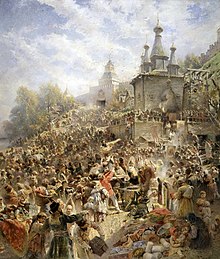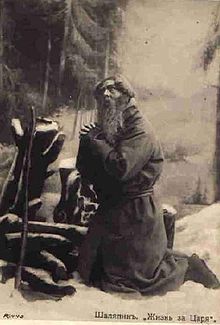Time of Troubles: Difference between revisions
Updated changed URL |
|||
| Line 26: | Line 26: | ||
The [[Polish king]], however, opposed the compromise, deciding to take the throne for himself and to convert Russia to [[Roman Catholicism]]. This scheme did not please any of the contending factions and it roused the [[anti-Catholic]] and [[anti-Polish]] sentiments of the nation. At the same time it was displeasing to the Swedes, who had become [[Polish-Swedish wars|rivals of the Poles]] on the [[Ingria|Baltic coast]], and they [[Ingrian War|declared war on Russia]], supporting a [[False Dmitriy III|false Dmitri of their own]] in [[Ivangorod]]. |
The [[Polish king]], however, opposed the compromise, deciding to take the throne for himself and to convert Russia to [[Roman Catholicism]]. This scheme did not please any of the contending factions and it roused the [[anti-Catholic]] and [[anti-Polish]] sentiments of the nation. At the same time it was displeasing to the Swedes, who had become [[Polish-Swedish wars|rivals of the Poles]] on the [[Ingria|Baltic coast]], and they [[Ingrian War|declared war on Russia]], supporting a [[False Dmitriy III|false Dmitri of their own]] in [[Ivangorod]]. |
||
Russia was now in a [[Failed state|very critical condition]]. The throne was vacant; the great nobles ([[boyar]]s) quarrelled among themselves; Orthodox [[Patriarch Hermogenes]] was imprisoned; Catholic [[Poles]] occupied the [[Moscow Kremlin]] and Smolensk; the [[Protestant]] Swedes occupied [[Novgorod]]; continuing [[Tatar invasions|Tatar raids]] left the south borderlands of Russia completely depopulated and devastated;<ref>[http://www.allempires. |
Russia was now in a [[Failed state|very critical condition]]. The throne was vacant; the great nobles ([[boyar]]s) quarrelled among themselves; Orthodox [[Patriarch Hermogenes]] was imprisoned; Catholic [[Poles]] occupied the [[Moscow Kremlin]] and Smolensk; the [[Protestant]] Swedes occupied [[Novgorod]]; continuing [[Tatar invasions|Tatar raids]] left the south borderlands of Russia completely depopulated and devastated;<ref>[http://www.allempires.info/article/index.php?q=The_Crimean_Khanate The Tatar Khanate of Crimea], allempires.net</ref> and enormous bands of brigands swarmed everywhere. Tens of thousands were dying in battles and riots; on March 17–19, 1611, the Poles and German mercenaries suppressing riots in Moscow massacred 7,000 Muscovites and set the city on fire.<ref name="Solovyov"> [[Sergey Solovyov]], ''History of Russia from the Earliest Times'', [http://lib.ru/HISTORY/SOLOVIEV/solv8.txt Vol. 8].</ref> Many other cities were also devastated or weakened. For example, on [[September 22]], [[1612]], the Poles and Lithuanians exterminated the population and clergy of Vologda.<ref name="Solovyov"/> |
||
==Struggle for independence== |
==Struggle for independence== |
||
Revision as of 14:43, 9 July 2009

The Time of Troubles ([Смутное время, Smutnoye Vremya] Error: {{Lang-xx}}: text has italic markup (help)) was a period of Russian history comprising the years of interregnum between the death of the last Russian Tsar Feodor Ivanovich of the Rurik Dynasty in 1598 and the establishment of the Romanov Dynasty in 1613. At the time, Russia was occupied by Polish-Lithuanian Commonwealth in the Dymytriads, and also suffered from civil uprisings, usurpers and impostors.
Causes
After Feodor's death without issue, his brother-in-law and closest adviser, boyar Boris Godunov, was elected his successor by a Great National Assembly (Zemsky Sobor). Godunov's short reign (1598–1605) was not as successful as his administration under the weak Feodor. Extremely poor harvests were encountered in 1601–1603, with nighttime temperatures in all summer months often below freezing, wrecking crops; see Russian famine of 1601–1603.[1] Widespread hunger led to mass starvations; the government distributed money and foodstuffs for poor people in Moscow, but that only led to refugees flocking to the capital and increasing the economic disorganization. The oligarchical faction, headed by the Romanovs, considered it a disgrace to obey a mere boyar; conspiracies were frequent; the rural districts were desolated by famine and plague; great bands of armed brigands roamed the country committing all manner of atrocities; the Don Cossacks on the frontier were restless; and the government showed itself incapable of maintaining order.
Under the influence of the great nobles who had unsuccessfully opposed the election of Godunov, the general discontent took the form of hostility to him as a usurper, and rumours were heard that the late tsar's younger brother Dmitri, supposed to be dead, was still alive and in hiding.
False Dmitriy
In 1603 a man calling himself Dmitri — first of the so-called False Dmitriys — and professing to be the rightful heir to the throne, appeared in the Polish-Lithuanian Commonwealth. In fact the younger son of Ivan the Terrible had been stabbed to death before his brother's death, allegedly by Godunov's order; and the mysterious individual who was impersonating him was an impostor but was regarded as the rightful heir by a large section of the population and gathered support both in Russia and outside its borders, particularly in the Commonwealth and the Papal States. Factions in the Commonwealth saw him as a tool to extend their influence over Russia, or at least gain wealth in return for their support; the Papacy saw it as an opportunity to increase the hold of Roman Catholicism over the Eastern Orthodox Russians.

A few months later he crossed the frontier with a small force of 4,000 Poles, Lithuanians, Russian exiles, German mercenaries and Cossacks from the Dnieper and the Don, in what marked the beginning of the Commonwealth intervention in Russia, or the Dymitriad wars. Although the Commonwealth had not officially declared war on Russia (as its king, Sigismund III Vasa, was opposed to the intervention), some powerful magnates decided to support False Dmitri with their own forces and money, expecting rich rewards afterwards. Dmitri was married per procura to Marina Mniszech, and immediately after Boris's death in 1605 he made his triumphal entry into Moscow.
Shuisky's reign
The reign of Dmitri was short. Before a year had passed a conspiracy was formed against him by an ambitious Rurikid prince (knyaz) called Vasily Shuisky, and he was murdered soon after his marriage in the Moscow Kremlin, together with many of his supporters who were brutally massacred.[2] It is estimated that 2,000 Poles were murdered by Shuisky and his men. The reaction to the massacre in Poland was strong, but it was decided to postpone revenge against those events.[3]
The chief conspirator, Shuisky, seized power and was elected tsar by an assembly composed of his faction, but neither the Russian boyars, nor the Commonwealth magnates, nor the pillaging Cossacks, nor the German mercenaries were satisfied with the change, and soon a new impostor, likewise calling himself Dmitri, son and heir of Ivan the Terrible, came forward as the rightful heir. Like his predecessor, he enjoyed the protection and support of the Polish–Lithuanian magnates. However after Shuisky signed an alliance with Sweden, the king of the Commonwealth, Sigismund III, seeing the Russian–Swedish alliance as a threat, now resolved to officially intervene in the internal affairs of Russia.
Second occupation
Polish–Lithuanian troops crossed the Russian borders and laid siege to the fortress of Smolensk. After the combined Russo–Swedish forces were destroyed at the Battle of Klushino, Shuisky was forced to abdicate. False Dmitrii II wasn't able to gain the throne, however, because the Polish commander, voivod, and magnate Stanisław Żółkiewski put forward a rival candidate in the person of Sigismund's son, Władysław. To this latter some people in Moscow swore allegiance on condition of his maintaining Orthodoxy and granting certain privileges to them. On this understanding the Polish troops were allowed to enter the city and occupy the Kremlin.
The Polish king, however, opposed the compromise, deciding to take the throne for himself and to convert Russia to Roman Catholicism. This scheme did not please any of the contending factions and it roused the anti-Catholic and anti-Polish sentiments of the nation. At the same time it was displeasing to the Swedes, who had become rivals of the Poles on the Baltic coast, and they declared war on Russia, supporting a false Dmitri of their own in Ivangorod.
Russia was now in a very critical condition. The throne was vacant; the great nobles (boyars) quarrelled among themselves; Orthodox Patriarch Hermogenes was imprisoned; Catholic Poles occupied the Moscow Kremlin and Smolensk; the Protestant Swedes occupied Novgorod; continuing Tatar raids left the south borderlands of Russia completely depopulated and devastated;[4] and enormous bands of brigands swarmed everywhere. Tens of thousands were dying in battles and riots; on March 17–19, 1611, the Poles and German mercenaries suppressing riots in Moscow massacred 7,000 Muscovites and set the city on fire.[5] Many other cities were also devastated or weakened. For example, on September 22, 1612, the Poles and Lithuanians exterminated the population and clergy of Vologda.[5]
Struggle for independence
The severity of the crisis produced a remedy, in the form of a patriotic rising of the nation under the leadership of Kuzma Minin, a Nizhny Novgorod merchant, and Prince Pozharsky. After battle for Moscow on October 22 Old Style[5] (November 1 New Style), the invaders retreated to the Kremlin, and on October 24–27 O.S.[6] (November 3–6 N.S.) the nearby Polish army was forced to retreat. The garrison in the Kremlin surrendered to the triumphant Pozharsky. On November 4, Russia officially celebrates the anniversary of this event as a Day of National Unity.
A Grand National Assembly elected as tsar Michael Romanov, the young son of the metropolitan Philaret, who was connected by marriage with the late dynasty and according to the legend had been saved from the enemies by a heroic peasant, Ivan Susanin.
The Ingrian Wars against Sweden lasted until the Treaty of Stolbovo in 1617 and the Dymitriad wars against the Commonwealth would last until the Peace of Deulino in 1619. Both forced Russia to make some territorial concessions, though the majority of them would be regained over the coming centuries. Most importantly, the crisis was instrumental in unifying all classes of the Russian society around the Romanov tsars and laid foundations for the powerful Russian Empire. However, Russian historian Andrei Novikov expressed a controversial view that "The Polish intervention represented a possibility for the crude Russia to get closer to Europe; instead, Russians chose hundreds of years of slavery".[7]
In popular culture

Story of Time of Troubles inspired many artists and playwrights in Russia and outside. Three most popular topics are Pozharsky/Minin liberation of Moscow, the struggle between Boris Godunov and False Dmitry, and a story of Ivan Susanin, a peasant who sacrificed himself to lead Poles away from Mikhail Romanov.
- Ivan Susanin, an opera by Mikhail Glinka
- Boris Godunov (play), a play by Alexander Pushkin
- Boris Godunov (opera), an opera based on Pushkin's play, by Modest Mussorgsky
- Minin and Pozharsky monument, on the Moscow Red Square
- Minin and Pozharsky, a film by Vsevolod Pudovkin
- 1612, a 2007 historical fantasy film
There are also a number of paintings by both Russian and Polish artists.
Notes
- ^ Borisenkov E, Pasetski V. The thousand-year annals of the extreme meteorological phenomena. ISBN 5-244-00212-0, p. 190.
- ^ John Stevens Cabot Abbott, The Empire of Russia; "The murderers ransacked the palace, penetrating every room, killing every Polish man and treating the Polish ladies with the utmost brutality."
- ^ John Stevens Cabot Abbott, The Empire of Russia; "The Poles were exasperated beyond measure at the massacre of so many of their nobles and at the insult offered to Mariana, the tzarina. But Poland was at that time distracted by civil strife, and the king found it expedient to postpone the hour of vengeance."
- ^ The Tatar Khanate of Crimea, allempires.net
- ^ a b c Sergey Solovyov, History of Russia from the Earliest Times, Vol. 8.
- ^ Nikolay Kostomarov, Russian History in Biographies of its main figures, Chap. 30.
- ^ As quoted in 'Car Samozwaniec jako mit i motyw literacki na przykładzie Dymitra I Samozwańca' by Tomasz Nakoneczny
See also
- Polish-Muscovite War (1605–1618)
- Bolotnikov rebellion of 1606-1607
References
This article incorporates text from a publication now in the public domain: Chisholm, Hugh, ed. (1911). Encyclopædia Britannica (11th ed.). Cambridge University Press. {{cite encyclopedia}}: Missing or empty |title= (help)
Further reading
- Dunning, Chester S.L. Russia's First Civil War: The Time of Troubles and the Founding of the Romanov Dynasty, Penn State Press, 2001 ISBN 0-271-02074-1
